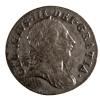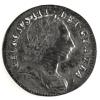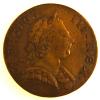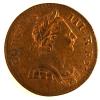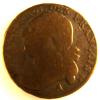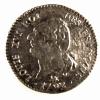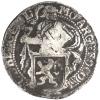You are here
Coinage of the Pre-revolutionary Era
Despite protests about British policies that kept specie from circulating in the American colonies, the coinage of Great Britain was the basis of the pre-Revolutionary monetary system. Its obverse depiction of the king was clearly inappropriate for the new republican coinage, but did suggest the basic image of a portrait bust as the most familiar obverse; the reverse depiction of Britannia on the halfpenny, the denomination most widely in circulation in the colonies, established the precedent for a human personification of an abstract concept.
The silver coinage in common circulation in the colonies was the Spanish piece of eight, known as the Spanish dollar for its monetary equivalence to coinages on the German thaler standard. This coin became less appropriate as a model for the North American coinage after 1772, when the symbolic (though expressly imperial) pillars of Hercules gave way to the monarch’s portrait as the obverse image.
In other monarchies, the image of the ruler also dominated the obverse of coins. The importance accorded this portrait resulted in its presence on the coinage of the first years of the Revolutionary government; as late as 1793, Louis XVI appeared on the obverse of French coins whose reverse proclaimed Year 5 of Liberty. Among the few non-monarchical minters—the Netherlands, Venice, the Swiss cantons, and the free imperial cities of the Holy Roman Empire—only the Netherlands offered appropriate numismatic imagery for the American Republic.
|
|
|
|
|
|
|
|
|
|
|
|
|
|
Only one coinage had been minted in the American colonies: the series of seventeenth-century silver issues of the Massachusetts Bay Colony. Most of these bear the date 1652 (when the British throne was vacant during the Civil War), but were actually minted intermittently in succeeding decades. Various privately minted tokens, some bearing references to America, were produced under royal patent and imported into the colonies in the eighteenth century to make up for the shortage of official British coins. In 1773 the colony of Virginia pressed its claim, based on its 1609 charter, to a right for its own coinage, for which the Tower Mint in London supplied a small issue.
As a monetary expedient, each American colony issued its own paper money—among the earliest of world banknotes—denominated in British pounds or Spanish dollars. These notes usually bore imagery related to the individual colony, but some included versions of the image of Britannia that appeared on the royal coinage.
|
|
|
|
|
|
|
|
|
|
|
|
|
|
|
|
|
|
|
Author’s copy presented to Isaac Green, April 17, 1890, with banknotes inserted into interleaved sheets. New Jersey: paper six shillings, twelve shillings, fifteen shillings, thirty shillings, three pounds, six pounds, all March 25, 1776. |



